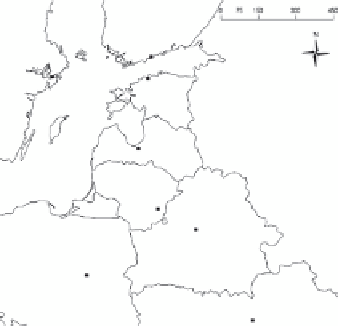Environmental Engineering Reference
In-Depth Information
showed a severe imbalance in the mineral nutrition of urban trees
[13]
. Investigation
in 2004/2005 revealed high concentrations of Na
+
and Cl
−
in the street snow melt
water, urban soil and
T. × vulgaris
leaves
[10]
. It is a topical problem as the street
greenery currently covers 39% of the total street length in the centre of Riga and in
general the status of trees could be characterized as damaged.
Our study was conducted to evaluate the toxic effect of soil and plant pollution
level with sodium and chlorine on potassium supply and ecological condition of the
street trees (
Tilia × vulgaris
) in Riga.
Materials and Methods
Riga, the capital of the Republic of Latvia, is situated along the Baltic Sea at the
southern part of the Gulf of Riga. The central part of the city is located on the right
bank of the Daugava river. The climate is moderately warm and humid. Summers
are relatively cloudy and cool. The average temperature in July is +16.9°C. Winters
are relatively warm with frequent thaws, the average temperature in January is −4.7°C.
The average amount of precipitation is 700-720 mm/year
[1]
.
Sampling
During the time period of March 2005 to August 2007, soil and leaf samples were
collected from 14 sites (45 trees) in the central part of Riga, and from a control site
(three lime trees) located in a park area - Viestura Garden (Fig.
1
, Table
1
). Soil
samples were collected from the tree-rooting zone (road side) with a soil probe to
a depth of 35 cm in March (the end of winter), June and July 2005, and June and
August 2007.
Finland
Sweden
Estonia
Russia
Latvia
Riga
Baltic Sea
Lithuania
Belarus
Poland
Ukraine
Fig. 1
Location of Riga in Europe




